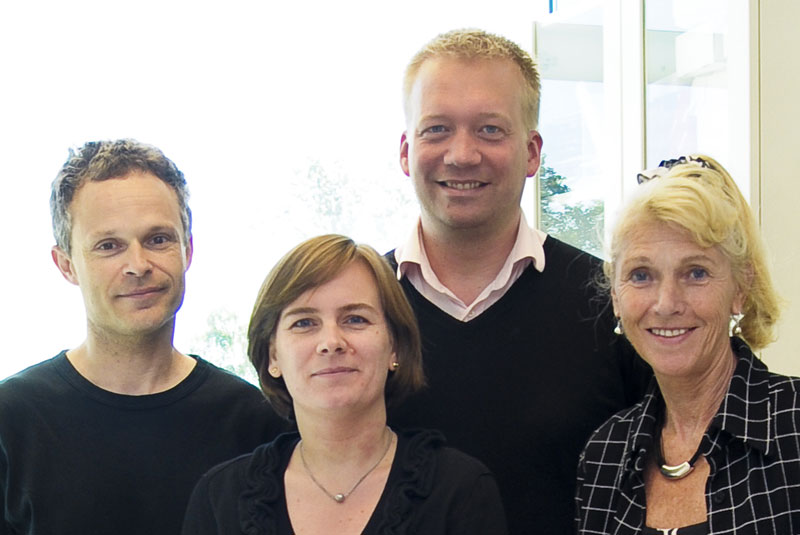Paper from Anne-Lise Børresen-Dale and co-workers published in "Science Translational Medicine"

An article entitled "Genomic architecture characterizes tumor progression paths and fate in breast cancer patients" is published in the June 30th issue of "Science Translational Medicine" - one of the three respected peer-reviews journals published by The American Association for the Advancement of Science (AAAS) (the others being Science and Science Signaling).
The study emphasizes the relationship between structural genomic alterations, molecular subtype and clinical behavior, and show that objective score of genomic complexity is an independent prognostic marker in breast cancer.
The AAAS press office believes this paper will attract considerable media attention.
Hege G. Russnes and Hans Kristian Moen Vollan share the first-authorship.
Summary of the findings - in the form of "Question & Answers" - prepared for the AAAS press office:
1. What is the most significant finding of your research paper?
In breast cancer, the genome (DNA) frequently undergoes alterations; some genes are lost and some genes are gained. In this study detailed information about such copy number alterations in tumor DNA from 595 breast carcinomas were studied and enabled us to make estimates of the structure of the genomic rearrangements; i.e. the individual tumors genomic "architecture". The most important finding in this work was that patients with tumors that had alterations of large DNA segments (such as a whole chromosome arms) had a better prognosis than patients where the tumor had altered DNA regions with a more complex structure. We used these structural patterns of genomic change to group tumors into four groups. These groups had distinct molecular alterations and different clinical behavior (such as survival); strengthening the hypothesis that breast cancer consists of several independent diseases.
Analysis of patients that were treated with surgery alone suggested that patients with tumors with genomic complexity had an inferior prognosis. A DNA based classification might thus identify new groups of patients that could benefit from adjuvant treatment.
Further, each of the four groups consisted of patients with better or worse survival. Of major importance was the finding that established prognostic markers such as histological grade and tumor size was only valid for two of the four groups. Better prognostic information in the two other groups seemed to be related to molecular alterations such as mutations or increased complexity.
2. What did you do in your experiment?
The data were obtained by different types of high-resolution aCGH (array Comparative Genomic Hybridization); a technique that gives information of DNA copy number. We studied tumor DNA from 595 breast cancer patients from four different series of breast cancer patients, some of these previously published and reanalyzed, some presented for the first time in this paper. By developing novel methods for analyzing copy number data we were able to merge the different datasets. Two novel scores measured the genomic architectural changes: WAAI (whole arm aberration index) and CAAI (complex arm aberration index). As the names imply, WAAI were specifically developed to capture whole arm chromosomal gains or losses and CAAI to identify localized complex rearrangements. The calculated WAAI and CAAI for every chromosome arm from all chromosomes revealed the architectural DNA changes in the individual tumors.
3. How do we start to apply your findings in people? How can patients benefit from your findings? Be specific about how these findings can translate into a new treatment or therapies for humans. I realize there may not be any actual treatments in testing right now, but whats the basic idea? What harmful process would a hypothetical drug or technique intervene with? Or, what helpful process would a drug/technique try to amplify?
First, the acknowledged heterogeneity of breast cancer has been an obstacle in breast cancer research the last decade. It is of major importance to be able to merge information from smaller sample sets into larger to be able to identify and study subtypes of breast cancer. The two markers used in this study, WAAI and CAAI, were designed to overcome this, and by merging four cohorts with long-term follow up, different subgroups of breast cancer could be studied in detail.
Secondly, this study supports the concept that breast cancer must be acknowledged as several different diseases. These subgroups differ both at the molecular level and in their clinical behavior. In the near future a proper breast cancer diagnosis will probably be multilayered; first a tumor must be designated to a group (like our WAAI groups), secondly there will be applied group-specific panels of markers for predicting therapy response.
And last, aCGH is a well-established method that can be part of molecular diagnostics today, and standardized algorithms such as WAAI and CAAI can prove valuable both to group tumors but also to guide treatment choices. Rearrangements can be detected both by aCGH and fluorescence microscopy using processed tissue; this is feasible when it comes to integrating the method into current cancer diagnostics. An external validation of our findings in an independent data set will be of importance, followed by a randomized clinical trial where aCGH and WAAI and CAAI are used as determinants.
4. Please make any comments on your research that you feel journalists should know (if any).
All data and all algorithms are public available and can be used and explored, and we believe it is not only breast cancer that can benefit from this approach.
Links:
Science Translational Medicine - current issue
